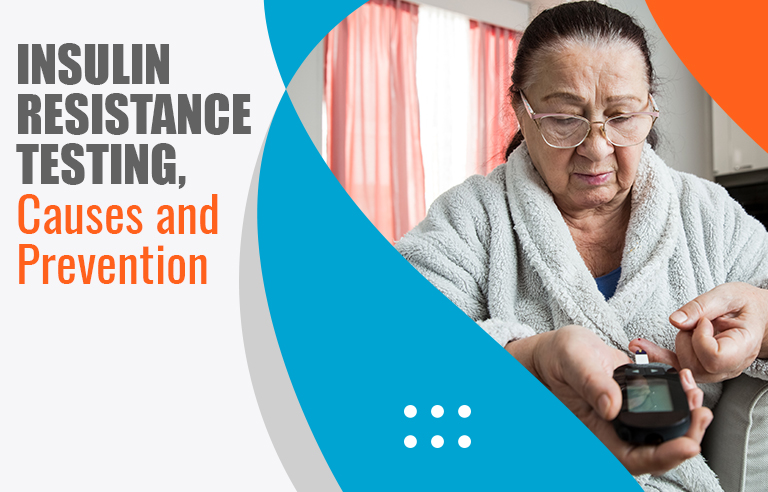
Did you know insulin resistance usually has no signs or symptoms? But it can be the first sign of serious health problems such as prediabetes or type 2 diabetes. There are tests for insulin resistance but it is important to understand the risk factors, necessary treatment and prevention.
We will discuss:
- What is Insulin?
- What is Insulin Resistance?
- Types of Insulin Resistance Tests
- Endocrine Issues Due to Insulin Resistance
- Who need to be Tested for Insulin Resistance?
- Symptoms of Insulin Resistance
- Prevention and Treatment of Insulin Resistance
What is insulin?
When glucose levels increase after eating or drinking, your pancreas will respond by producing a hormone called insulin. The role of insulin is to allow glucose to enter into the cells so that it gets converted in the form of energy. When glucose levels begin to decrease in the bloodstream, your pancreas gets a signal to reduce the amount of insulin it is producing.
How insulin works:
- When you are eating, the food is broken down into glucose and enters into the bloodstream.
- Your pancreas gets a signal to produce insulin.
- Insulin helps glucose to enter your cells so that it can be used in the form of energy. It tells the liver to store glucose for future use.
- When glucose enters into your cells, the bloodstream levels begin to decrease. This will tell your pancreas to lessen the amount of insulin it is releasing.
- If insulin levels reduce further, your liver releases the glucose it has stored.
What is insulin resistance?
Insulin resistance or impaired insulin sensitivity occurs when the cells find it difficult to respond to the hormone. When this happens, the step-by-step process listed above can go wrong and an insulin resistance test is the way that it can be identified.
When the cells develop impaired response to insulin, your body may compensate by preparing more insulin. If your pancreas can create sufficient extra insulin to help glucose enter into your cells, the glucose levels will remain in check. But if your pancreas cannot produce enough insulin to keep up with demand, it may give rise to:
- Too much glucose in the bloodstream
- Prediabetes or development of type 2 diabetes
- Cells may become insulin resistant
Types of Insulin Resistance Tests
Insulin resistance is not commonly tested but when prediabetes or type 2 diabetes is suspected, a doctor will ask you to have a private insulin resistance test in UK. The most common insulin resistance tests are:
- Fasting plasma glucose test (FPG) – This test can diagnose prediabetes and diabetes by testing the blood sugar levels of a person after they have fasted overnight. The blood panel consists of FPG tests which makes it a common insulin resistance test.
- Oral glucose tolerance test (OGTT) – This test is done after an overnight fast. The doctor takes your blood sample and you will be asked to drink a high-glucose beverage. Additional blood samples will be taken at specific intervals, usually two to three hours. The results will be compared to evaluate how your body processes glucose.
- Random blood glucose test (RBG) – An RBG test helps to measure the sugar level at any time during the day, without fasting. The test is done when quick diagnosis is essential.
- A1C test – Also called glycosylated haemoglobin or haemoglobin A1C, HbA1c test measures the blood sugar levels of a person from the past two to three months. The haemoglobin is a protein present in red blood cells which carries oxygen to cells. Both haemoglobin and glucose join into the bloodstream and A1C test calculates the haemoglobin, coated with glucose, percentage.
Endocrine issues due to insulin resistance
Insulin resistance
Having excess amounts of glucose in the bloodstream can damage your body. This can cause an increase in insulin which signals to the muscles and liver that they should store glucose. The liver then sends excess glucose to fat cells causing weight gain. During this stage, the body’s impaired insulin response sets the foundation for other health problems to develop.
Your healthcare team may ask you to have an insulin resistance test and check for the following:
- Prediabetes – Prediabetes is a precursor for type 2 diabetes where the glucose levels are elevated but not enough for a diagnosis of diabetes. Prediabetes develops in people who are have a resistance to insulin and increases the risk of cardiovascular disease, type 2 diabetes and stroke.
- Type 2 Diabetes – Type 2 diabetes will follow on from prediabetes when insulin resistance is sustained. It is caused by the inability of your body to use or produce sufficient amount of insulin. This means you will not be able to maintain normal blood glucose levels. Type 2 diabetes is the more common form of diabetes when compared with type 1 diabetes where your pancreas cannot produce any insulin, due to an autoimmune-related condition.
- Gestational Diabetes – Pregnant women may be at risk of gestational diabetes and this type of diabetes generally develops during the 24th week of pregnancy. This happens due to substantial changes in a woman’s body at the time of pregnancy such as weight gain and an increase in the production of hormones. Due to these changes, the body will have difficulty in using insulin effectively and a woman may develop insulin resistance.
Who need to be tested for insulin resistance?
The tests for insulin resistance are done for people who suffer from certain genetic and lifestyle risk factors. Some factors which may make people more likely to develop insulin resistance and probably prediabetes include the following:
- Being 45 years or older
- Being obese or overweight
- Having a past history of gestational diabetes, polycystic ovary syndrome (PCOS), stroke or heart disease
- Health problems such as high blood pressure or abnormal cholesterol levels.
- Past history of diabetes in the family
- Physical inactivity
- Hormonal disorders like acromegaly or Cushing’s syndrome
- Sleep problems like sleep apnoea
Symptoms of Insulin Resistance
Insulin resistance will usually be asymptomatic till it turns into prediabetes or type 2 diabetes. But some people with severe insulin resistance may develop acanthosis nigricans, which means darkened skin that can appear on your armpit or the side or back of neck. Your doctor may ask you to take a test for prediabetes if you have any previously mentioned risk factors. If you are tested and your results seem to be normal, your doctor will likely retest you every few years.
Prevention and Treatment for Insulin Resistance
If your lack of physical activity has been linked with insulin resistance and prediabetes. People who are at greater risk of developing diabetes may lessen the risk by losing 5% to 7% of their weight through physical activity and a change in their diet. Creating a customised meal plan may help to lessen insulin resistance. This meal plan can include your food preferences, health goals, work schedule, weight and more.
If your healthcare professional suggests increasing physical activity and losing weight, the addition of mild to moderate exercise to your daily routine may help your body to improve blood glucose levels and respond to insulin. You may even be asked to take a step towards eating healthier food and losing excess weight, to reverse insulin resistance, and delay the onset of type 2 diabetes if you presently have prediabetes.
Worried about insulin resistance or have further questions related to your health?
Call our doctors now at 020 70434317 and inquire about insulin resistance testing to receive individualised recommendations. Check with our healthcare professional at GP London before making any significant changes to your lifestyle.



-min.jpg)

